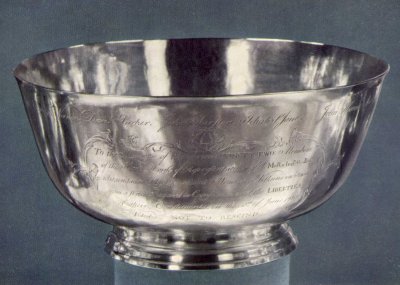

New England
The Revere Bowl
The Revere Bowl Story begins in February 1768 when Samuel Adams and James Otis, two members of the Massachusetts Assembly, drafted a resolution and a circular letter that were adopted by the Assembly and sent to all of the other 12 colonial assemblies. With indignation, the resolution called attention to the Townsend Acts enacted by Parliament in February 1767. The Townsend Acts were deemed “obviously unconstitutional” because the colonies had no direct representation in Parliament. The circular letter exhorted the other 12 Assemblies to join Massachusetts in petitioning George III to exert his influence on Parliament to repeal the Townsend Acts.
The Townsend Acts provided for import taxes initially on most imports. Amendments to the Acts subsequently included all imports – even tea. Because of their enormous unpopularity, all but one of the Townsend Acts were repealed one by one, but Parliament stubbornly refused to repeal the import taxes on tea. The alleged purpose of the import taxes was to raise revenue to pay for the expenses of the British army stationed in the colonies to protect the colonists from the French and the Indians, and to pay for the expenses of the French and Indian war. The colonists refused to raise sufficient funds and to conscript in sufficient numbers to provide for their own defense-an attitude that would soon change.
Lord Hillsborough, the Royal Secretary of the Colonies, who was stationed in Boston, was informed of the resolution and the circular letter. He call in the Royal Governor of Massachusetts, Francis Bernard, and in a rage ordered him to go to the Assembly and demand that the resolution and the circular letter be rescinded. He instructed Governor Bernard to dismiss the Assembly if they refused to do it. The Assembly immediately took up the issue and in an acrimonious debate lasting more than two hours, James Otis allegedly made the now famous statement “no taxation without representation”. Finally, the matter came to a vote and the vote was 92 to 17 against rescinding the resolution and the circular letter.

Paul Revere, a silversmith master craftsman, a very successful entrepreneur in several businesses, and a consummate political activist, was commissioned by the Sons of Liberty-a patriotic and drinking society of which he was a member-to design and execute in silver a tribute to commemorate the vote and immortalize the 92 who were courageous enough to vote against rescinding the resolution and the circular letter. Revere was instructed to design a silver rum punch bowl to be made of 45 ounces of silver and to hold 45 gills of rum. Revere engraved the bowl with historical symbols and references as well as with the names of 17 members of the Sons of Liberty along with the numbers 45 and 92 bowl . The design of the bowl was inspired by Chinese commemorative porcelain bowls produced for the American and British markets. After a series of private ownership, the commemorative silver bowl designed and executed by Revere was purchased by the Museum of Fine Arts of Boston with money donated by the school children of Massachusetts for that purpose.
Revere named his bowl the Liberty Bowl, and with it a local tradition was established. Engraved copies of his Liberty Bowl are commonly referred to as Revere Bowls. They are widely used especially by local organizations to commemorate special events or achievements of individuals or organizations.
–Kindly provided by George Santos, MD
“Unconstitutional…”
The British do not have a constitution. However, for centuries the British have held the concepts of “constitutional” and “unconstitutional”. These concepts are part of our British heritage. When the British speak of the constitution, they refer to a series of documents that includes the Magna Carta, amended 10 years after it was signed by King Alfred, The Declaration of Rights enacted by Parliament in 1689, Common Law and precedence. The Declaration of Rights of 1689 is the paradigm for the American State and Federal Constitutions.
“45 ounces…”
The significance of the number 45 is that it was the cell number of John Wilkes in the Tower of London. Wilkes was imprisoned twice in the Tower of London for his writings critical of the King. He was considered a political radical; he supported economic and parliamentary reform, and the independence of the American colonies. He won election to Parliament while occupying cell #45 in the Tower of London! He enjoyed enormous popularity on both sides of the Atlantic.
Interested in Becoming an Exhibitor?
Become an ExhibitorEngage with New England ophthalmologists and other related professionals... Exhibit at any of our educational programs!
Find out more about this exciting opportunityBecome a Member
Providing an unparalleled environment of collegiality and continuing education. NEOS offers its members world-class meetings within a short car or train ride.
Join NowDonate Now
Assure the continuing education of New England ophthalmologists and promote public awareness of ophthalmology
Donate Now